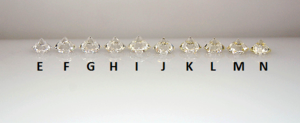Hi,
I'm new to the forum and was hoping to gain some advice in purchasing a loose stone to use in an engagement ring. The extent of my knowledge is limited to Fred Cuellar's How to Buy a Diamond book.
I understand that there are many factors to consider after having read the book. Although it is very informative, the overall experience is becoming overwhelming. I want to strike a good balance between feeling comfortable with my purchase, without having to become an expert in the field. I also understand that a merchant is profiting from the sale. I have no concept of what my stone should cost, nor what a reasonable mark up should be. Here's where I'm asking for your help...
Ideally, I would like to spend $13,000, with +/- $1,000 wiggle room. I am interested in a 1.5-1.7 carat stone, G-I, VVS1-VS2, without fluorescence. I would also like the center of the stone to be free from inclusions. My goal, like that of most, is to mask the inclusions with prongs. According to the literature, I should also be looking for a well proportioned stone in order for it to reflect light and create "shine." The book refers to this as the Class I Tolkowsky cut, with a focus on the pavilion angle.
Given my price range, are these expectations realistic in today's market? If not, where should I be looking to compromise? Also, where are good places to start my search for this type of stone? I am located in the NYC area and am open to suggestions. Lastly, which additional one or two factors would you recommend considering during my search?
I appreciate your help!
I'm new to the forum and was hoping to gain some advice in purchasing a loose stone to use in an engagement ring. The extent of my knowledge is limited to Fred Cuellar's How to Buy a Diamond book.
I understand that there are many factors to consider after having read the book. Although it is very informative, the overall experience is becoming overwhelming. I want to strike a good balance between feeling comfortable with my purchase, without having to become an expert in the field. I also understand that a merchant is profiting from the sale. I have no concept of what my stone should cost, nor what a reasonable mark up should be. Here's where I'm asking for your help...
Ideally, I would like to spend $13,000, with +/- $1,000 wiggle room. I am interested in a 1.5-1.7 carat stone, G-I, VVS1-VS2, without fluorescence. I would also like the center of the stone to be free from inclusions. My goal, like that of most, is to mask the inclusions with prongs. According to the literature, I should also be looking for a well proportioned stone in order for it to reflect light and create "shine." The book refers to this as the Class I Tolkowsky cut, with a focus on the pavilion angle.
Given my price range, are these expectations realistic in today's market? If not, where should I be looking to compromise? Also, where are good places to start my search for this type of stone? I am located in the NYC area and am open to suggestions. Lastly, which additional one or two factors would you recommend considering during my search?
I appreciate your help!








300x240.png)